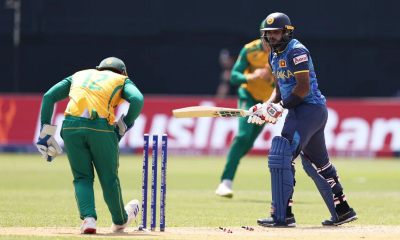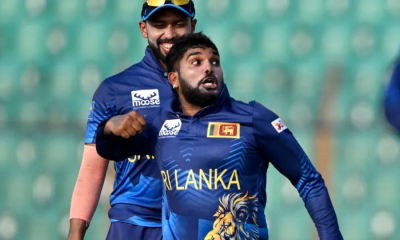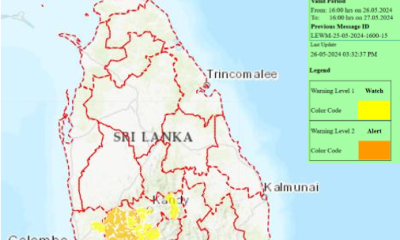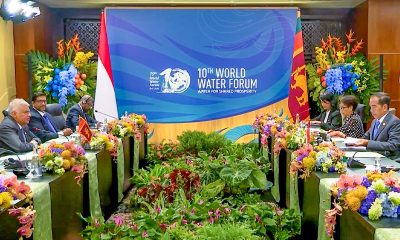Features
Unravelling Sri Lanka’s great mysteries
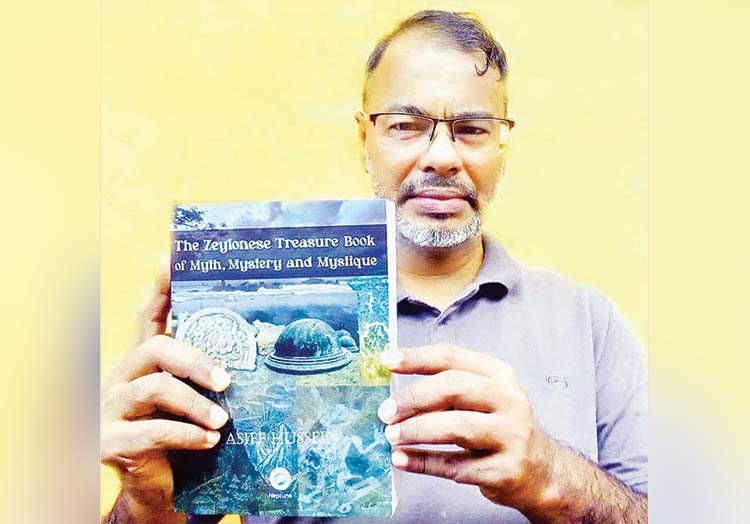
Asiff Hussein, author of The Zeylonese Treasure Book on Myth, Mystery and Mystique, traces the origins of some well-known but elusive local beliefs and legends
Interviewed by Ifham Nizam
Q: The Zeylonese Treasure Book of Myth, Mystery and Mystique you wrote was a pioneering attempt at solving some yet unsolved mysteries which have eluded many. Could you elucidate some of them for the benefit of our readers?
A: The book deals with a hundred such topics, from the whereabouts of Ravana’s kingdom, the strange sanctity of Adam’s Peak, the legendary Nagas, a missing race of dwarfs, cannibalistic women, lost gold mines, buried treasure, strange phenomena and other oddities such as the mysterious female spectre known as Mohini, to name just a few.
What I have done is adopt a multi-disciplinary approach to the problem at hand, incorporating historical notices, archaeological evidence, a study of etymology or word origins, etc., to come to a tenable solution to these problems. Also, very important is to interpret historical data through a modern lens.
For example, we read in the Mahavamsa that during the reign of King Sirisanghabodhi, a Yakkha (Demon) named Rattakkhi (Red Eye) came here and made the eyes of people red, causing their deaths. This ancient account may well be a reference to a fatal epidemic that swept through Sri Lanka in the 3rd century. One of the telltale symptoms of Rattakkhi, according to the chronicle, was Red Eyes, a condition where the white of the eye becomes reddened. Although we cannot say for certain what it was, given the reference to red eyes followed by the death of the victims, we can only guess that it might have been an outbreak of a deadly mutant strain of cholera.
Another example is the origins of the ancient temple of Tirukonesvaram in Trincomalee, the origins of which are recounted in hoary old Tamil tradition, faithfully recorded by Sir Emerson Tennent in his book Ceylon, published in 1860, where it is stated: “A Hindu prince, having ascertained from the Puranas that the rock of Trincomalie was a holy fragment of the golden mountain of Meru, hurled into its present site during a conflict of the gods, repaired to Ceylon and erected upon it a temple to Siva”.
This is a very interesting account as it may suggest how the temple came to be founded. The reference to a fragment of the sacred mountain Meru flung here in a conflict between the gods may well be a recollection of some ancient meteorite that fell here and later came to be worshipped as a lingam or relic, setting in motion the building of this temple of a thousand columns that was later razed to the ground by the intolerant Portuguese conquistadors. The Hindu temple that presently stands in its place is only a shell of its former self.
Q: You have made a painstaking effort to trace the origins of some of our local legends such as the origin of Mohini. Would you care to elaborate a bit on this, how she came to be?
A: Mohini, as we know, is a sort of female spirit who is said to appear to travellers in the middle hours of the night, dressed in white, half-clad to expose her body and cradling a babe in her arms. She would beseech unsuspecting travellers to hold the child while she tightens her garment. No sooner they do so, she would vanish into thin air with her child. Her victims would take on an unusual pallor, develop a high fever and go berserk before dying an untimely death.
This belief is at least a 100 years old, probably more. Perhaps the earliest reference to it is the so-called Teldeniya Ghost mentioned by a writer simply known as L.A.D in his Some Ceylon Ghost Stories published in the Times of Ceylon, Christmas Number 1925. L.A.D says of this phantom: “It appears that her particular friends are cartmen, who rest themselves and their weary cattle by the roadside, and begin to cook a mid-night meal.
With a crying child in her arms, and tears flowing down her cheeks, she creeps from the shadows, and begs them to escort her to a neighbouring village, explaining that she has lost her way and is benighted. Beauty in distress appeals to them as it does to every gallant heart, and they immediately offer assistance. One fatherly man lifts the crying babe from her arms, and attempts to pacify it, but as he does so the girl vanishes. They search for her in bewilderment, and the baby disappears mysteriously, too.
This is more than even a cartman can stand, and they hastily yoke the bullocks to the carts, and hurry away. The following day the unfortunate man who held the baby dies suddenly, and ghostly mocking laughter is heard in the night. His relatives feel quite peeved over it all, but are helpless, and what is worse, the poor bereaved wives cannot have the satisfaction of pulling the hussy’s hair, or of biting her”.
It seems from the above account that belief in the Mohini was once not as widespread as today and it is possible that even a 100 years ago it was localised to Teldeniya and neighbouring areas. This is supported by the folk tale of Galmal Oya Pokuti recorded by Sandaruvan Lokuhewa in his Dumbara Janakata (2011) which tells of a woman named Kumarihami, who upon seeing her little son floating lifeless in a body of water, committed suicide by jumping into it.
She is said to have been reborn as Pokuti, a sort of she-demon taking her name from her pokutuor curly hair, and haunting the area known as Katubokkuva on the Teldeniya-Hunnasgiriya road in the dead of night, taking form as a beautiful woman with babe in arms and telling travellers “Aney, me daruva tikak atata ganta ko, mage redipota aenda gannakal” (Please take this child in your arms while I correct my attire). If the man as much as holds the child, he would certainly die, this legend tells us.
Q: You have also made a detailed attempt to trace the origins of our lost tribes, such as the Nagas. What is your take on the Nagas, did they really exist in ancient Lanka or are they the stuff of myth?
A: Although I was earlier very sceptical that such a race known as Nagas existed in our country, I have lately revised this view to admit the possibility that they might have well lived here in ancient times.
These Nagas,if at all they existed, were probably Austronesian or Malayo-Polynesian pirates and seafarers. These were the folk, known as Orang Lautor ‘Sea Peoples,’ who had made the sea their principal domain and who in later times possibly settled in the southern parts of our island. A good many old accounts connect them with piracy, seafaring and settlements on the coast or river mouths.
The ancient Sinhalese chronicle, Dipavamsa speaks of the pious Naga named Maniakkhika who lived in Lanka in the time of the Buddha, around the 6th or 5th century BC, when it states: “At the mouth of the Kalyani river, there lived a Naga together with his children and a great retinue of Nagas”. We also read in the Mahavamsa that the Naga King Mahodara had his Naga Kingdom”in the Ocean that covered half a thousand yojanas”. This work also tells us that when the Theri Sanghamitta was conveying the great Bodhi tree from the dominion of Emperor Asoka to Sri Lanka and had fared forth into the sea, the Nagas practiced their magic to win it.
Hoary old local tradition also records that there once lived in a village, to the West of Anuradhapura, a beautiful woman named Hema who got romantically involved with a merchant who resorted to Mantota. When he left for his country, the infatuated maiden, unable to bear the delay in his return, took to the sea one night in desperate hope of finding him. She was captured by a Naga-Raja or Naga King to whom she preached Buddhism and who, being pleased with her, rewarded her with a valuable gemstone.
Such stories, though of a seemingly mythical character, suggest that the Nagas were thought to be a seafaring nation, thus connecting them to the Malayo-Polynesians. Although the Nagas of these stories seem to have been thought of as water-spirits, living beneath the waters, it is possible that the idea evolved from the sea-pirating activities of maritime Oceanic or Malayo-Polynesian peoples which is known to have taken place in ancient times. This idea finds support in Kshmendra’s Bodhisattvavadana Kalpalata of the 10th century which records serious depredations against maritime trade in the Gulf of Bengal by Naga sea pirates from the days of King Asoka.
This suggests a connection of the Nagas with the freebooting sea people in the seas in and around West Malayo-Indonesia who are very ancient and already mentioned in early Chinese accounts of the region.
It is quite possible that it was the Naga race that introduced to our island the Oruva or Outrigger canoe, the coconut and the culture of betel chewing, not to mention a faint mongoloid strain found among some Sinhalese. It is pertinent that Sinhalese folk tradition holds that the betel vine was introduced from the Naga world and this was known among the ancient Austronesians as bulu which could well account for the Sinhala word for betel bulat, from bulu-pat ‘betel leaf’.
Q: In your book, you have propounded some interesting new theories, including the rather outlandish view that the Skanda god of Kataragama had his origins in Alexander the Great. How would you justify such a view?
A: Whether we like it or not, there are many similarities between Alexander and Skanda. Both the names Alexander and Skanda are very similar sounding especially when we consider that the eastern form of Alexander was Iskandar or Sikkandar.
Strangely, the Sinhalese tradition also knew the Kataragama deity as Iskanda, which it attributed to the Brahmins, who, wanting to give him a name and knowing well that he would do heroic deeds and end up possessing a heap of heads, called him Iskanda (Mountain of heads). Iskanda is said to have, as a young man, committed all sorts of heroic acts and a lot of terrible things and was thus exiled by way of a ship that eventually landed in Devundara whence he proceeded eastwards on foot a long way (katara) when he came to a village which was henceforth called Kataragama.
This derivation is no doubt due to folk etymology. This means that when the original meaning of a particular word has been lost over time, later folk tend to give other explanations as to its meaning. So here we find the older name of Iskanda being preserved bringing it closer to the name by which Alexander was known in the East, Iskandar.
Alexander was a prince of Macedon and Skanda, too, we know, was given the princely epithet of Skanda Kumara ‘Prince Skanda’. It might also reflect Alexander’s supposed claim to be the son of Zeus, in this case the epithet kumara being simply a reference to his sonship in relation to Zeus of Ammon whom later Hinduism must have confounded with Siva, thus making him to be a son of Siva.
Alexander was also regarded as the Warrior par excellence and Skanda was known as Mahasena ‘Great Army’ meaning a commander of the Army. That he was once considered the God of War and may have been originally worshipped by soldiers may be the reason why he was called Kanda Surindu Mahasen (The Soldier God Skanda). We also know that the Kataragama deity was much feared, being regarded as the god of war, and in the olden days struck terror to those who even as much as heard his name. Alexander, too, we know, was both loved and feared in his lifetime, often more feared than loved due to his warmongering and reputation as a stern administrator. In contrast, Murugan, with whom he is today often confounded, especially by Hindus, is never feared as such by his devotees.
Another proof of Skanda’s connection to Alexander is seen in the velor lance as the symbol of the deity which can be seen planted in the ground at Kataragama. Pilgrims would bring iron lances which they leave as votive offerings and silver needles with which they pierce their cheeks and tongues. These are actually regarded as little lances and taken to be symbols of the deity himself.
The fact that the lance was regarded as the symbol of the deity suggests his military character was deemed to be very important by his worshippers of an earlier age who came up with these rituals. Likewise, we find Alexander being depicted holding a lance or spear as his weapon of choice in the Issus Mosaic which is believed to be a Roman copy of an original painting by Philoxenus and which was produced during Alexander’s lifetime or shortly afterwards.
The similarities go on. Alexander conquered Persia whose Shahs of later times were seated on the Peacock Throne and to this day the vehicle of Skanda or Kataragama Deviyo as he is called locally is the peacock. Alexander encouraged mixed marriages between the Macedonians of the West and Persians of the East and himself married a Sogdian princess named Roxana, while in local tradition we have Skanda the foreigner marrying the Vedda girl Valli. Such resemblances are too close to be dismissed.
Another possible vestige of Macedonian influence that survived was to be seen a little more than a 100 years ago during the festival of the shrine that took place in the Esala period (July-August). C.A.Murray, a British Government Agent who supervised the Kataragama festival in 1897, had this to say about it: “Six women take part in the procession, walking in front of the elephant. They have their hair done up in a peculiar Grecian style, the secret of which it is said no one can master”.
The supposed date of Skanda’s arrival here is also pertinent, since it places it fairly close to Alexander’s period. The Okanda Devala near the beach in Yala is said to have been erected on the site where Skanda landed in the island on his way to Katararagama about 2,000 years ago.
What we must understand here is that when a deity is said to visit a particular country, it does not necessarily mean that he in his human form prior to deification physically visited the locality but more probably meant that his cult had spread to these parts. Thus, it is possible that Greek or Macedonian worshippers of Alexander, possibly those given to military pursuits, perhaps even mercenaries, had arrived here long ago before establishing his worship in the country. This is supported by the finding of a Greek or Macedonian coin in Tissamaharama in the Southern part of the country. It is therefore quite possible that soldiers or mercenaries from the Balkan or Mediterranean region, or who knows, even Hellenized Egypt, where Alexander was worshipped following his death had settled here in times long past.
There is a lot we can discern from old stories and legends but it depends how far we are willing to think out of the box and interpret them through a modern lens.
Features
The heart-friendly health minister

by Dr Gotabhya Ranasinghe
Senior Consultant Cardiologist
National Hospital Sri Lanka
When we sought a meeting with Hon Dr. Ramesh Pathirana, Minister of Health, he graciously cleared his busy schedule to accommodate us. Renowned for his attentive listening and deep understanding, Minister Pathirana is dedicated to advancing the health sector. His openness and transparency exemplify the qualities of an exemplary politician and minister.
Dr. Palitha Mahipala, the current Health Secretary, demonstrates both commendable enthusiasm and unwavering support. This combination of attributes makes him a highly compatible colleague for the esteemed Minister of Health.
Our discussion centered on a project that has been in the works for the past 30 years, one that no other minister had managed to advance.
Minister Pathirana, however, recognized the project’s significance and its potential to revolutionize care for heart patients.
The project involves the construction of a state-of-the-art facility at the premises of the National Hospital Colombo. The project’s location within the premises of the National Hospital underscores its importance and relevance to the healthcare infrastructure of the nation.
This facility will include a cardiology building and a tertiary care center, equipped with the latest technology to handle and treat all types of heart-related conditions and surgeries.
Securing funding was a major milestone for this initiative. Minister Pathirana successfully obtained approval for a $40 billion loan from the Asian Development Bank. With the funding in place, the foundation stone is scheduled to be laid in September this year, and construction will begin in January 2025.
This project guarantees a consistent and uninterrupted supply of stents and related medications for heart patients. As a result, patients will have timely access to essential medical supplies during their treatment and recovery. By securing these critical resources, the project aims to enhance patient outcomes, minimize treatment delays, and maintain the highest standards of cardiac care.
Upon its fruition, this monumental building will serve as a beacon of hope and healing, symbolizing the unwavering dedication to improving patient outcomes and fostering a healthier society.We anticipate a future marked by significant progress and positive outcomes in Sri Lanka’s cardiovascular treatment landscape within the foreseeable timeframe.
Features
A LOVING TRIBUTE TO JESUIT FR. ALOYSIUS PIERIS ON HIS 90th BIRTHDAY

by Fr. Emmanuel Fernando, OMI
Jesuit Fr. Aloysius Pieris (affectionately called Fr. Aloy) celebrated his 90th birthday on April 9, 2024 and I, as the editor of our Oblate Journal, THE MISSIONARY OBLATE had gone to press by that time. Immediately I decided to publish an article, appreciating the untiring selfless services he continues to offer for inter-Faith dialogue, the renewal of the Catholic Church, his concern for the poor and the suffering Sri Lankan masses and to me, the present writer.
It was in 1988, when I was appointed Director of the Oblate Scholastics at Ampitiya by the then Oblate Provincial Fr. Anselm Silva, that I came to know Fr. Aloy more closely. Knowing well his expertise in matters spiritual, theological, Indological and pastoral, and with the collaborative spirit of my companion-formators, our Oblate Scholastics were sent to Tulana, the Research and Encounter Centre, Kelaniya, of which he is the Founder-Director, for ‘exposure-programmes’ on matters spiritual, biblical, theological and pastoral. Some of these dimensions according to my view and that of my companion-formators, were not available at the National Seminary, Ampitiya.
Ever since that time, our Oblate formators/ accompaniers at the Oblate Scholasticate, Ampitiya , have continued to send our Oblate Scholastics to Tulana Centre for deepening their insights and convictions regarding matters needed to serve the people in today’s context. Fr. Aloy also had tried very enthusiastically with the Oblate team headed by Frs. Oswald Firth and Clement Waidyasekara to begin a Theologate, directed by the Religious Congregations in Sri Lanka, for the contextual formation/ accompaniment of their members. It should very well be a desired goal of the Leaders / Provincials of the Religious Congregations.
Besides being a formator/accompanier at the Oblate Scholasticate, I was entrusted also with the task of editing and publishing our Oblate journal, ‘The Missionary Oblate’. To maintain the quality of the journal I continue to depend on Fr. Aloy for his thought-provoking and stimulating articles on Biblical Spirituality, Biblical Theology and Ecclesiology. I am very grateful to him for his generous assistance. Of late, his writings on renewal of the Church, initiated by Pope St. John XX111 and continued by Pope Francis through the Synodal path, published in our Oblate journal, enable our readers to focus their attention also on the needed renewal in the Catholic Church in Sri Lanka. Fr. Aloy appreciated very much the Synodal path adopted by the Jesuit Pope Francis for the renewal of the Church, rooted very much on prayerful discernment. In my Religious and presbyteral life, Fr.Aloy continues to be my spiritual animator / guide and ongoing formator / acccompanier.
Fr. Aloysius Pieris, BA Hons (Lond), LPh (SHC, India), STL (PFT, Naples), PhD (SLU/VC), ThD (Tilburg), D.Ltt (KU), has been one of the eminent Asian theologians well recognized internationally and one who has lectured and held visiting chairs in many universities both in the West and in the East. Many members of Religious Congregations from Asian countries have benefited from his lectures and guidance in the East Asian Pastoral Institute (EAPI) in Manila, Philippines. He had been a Theologian consulted by the Federation of Asian Bishops’ Conferences for many years. During his professorship at the Gregorian University in Rome, he was called to be a member of a special group of advisers on other religions consulted by Pope Paul VI.
Fr. Aloy is the author of more than 30 books and well over 500 Research Papers. Some of his books and articles have been translated and published in several countries. Among those books, one can find the following: 1) The Genesis of an Asian Theology of Liberation (An Autobiographical Excursus on the Art of Theologising in Asia, 2) An Asian Theology of Liberation, 3) Providential Timeliness of Vatican 11 (a long-overdue halt to a scandalous millennium, 4) Give Vatican 11 a chance, 5) Leadership in the Church, 6) Relishing our faith in working for justice (Themes for study and discussion), 7) A Message meant mainly, not exclusively for Jesuits (Background information necessary for helping Francis renew the Church), 8) Lent in Lanka (Reflections and Resolutions, 9) Love meets wisdom (A Christian Experience of Buddhism, 10) Fire and Water 11) God’s Reign for God’s poor, 12) Our Unhiddden Agenda (How we Jesuits work, pray and form our men). He is also the Editor of two journals, Vagdevi, Journal of Religious Reflection and Dialogue, New Series.
Fr. Aloy has a BA in Pali and Sanskrit from the University of London and a Ph.D in Buddhist Philosophy from the University of Sri Lankan, Vidyodaya Campus. On Nov. 23, 2019, he was awarded the prestigious honorary Doctorate of Literature (D.Litt) by the Chancellor of the University of Kelaniya, the Most Venerable Welamitiyawe Dharmakirthi Sri Kusala Dhamma Thera.
Fr. Aloy continues to be a promoter of Gospel values and virtues. Justice as a constitutive dimension of love and social concern for the downtrodden masses are very much noted in his life and work. He had very much appreciated the commitment of the late Fr. Joseph (Joe) Fernando, the National Director of the Social and Economic Centre (SEDEC) for the poor.
In Sri Lanka, a few religious Congregations – the Good Shepherd Sisters, the Christian Brothers, the Marist Brothers and the Oblates – have invited him to animate their members especially during their Provincial Congresses, Chapters and International Conferences. The mainline Christian Churches also have sought his advice and followed his seminars. I, for one, regret very much, that the Sri Lankan authorities of the Catholic Church –today’s Hierarchy—- have not sought Fr.
Aloy’s expertise for the renewal of the Catholic Church in Sri Lanka and thus have not benefited from the immense store of wisdom and insight that he can offer to our local Church while the Sri Lankan bishops who governed the Catholic church in the immediate aftermath of the Second Vatican Council (Edmund Fernando OMI, Anthony de Saram, Leo Nanayakkara OSB, Frank Marcus Fernando, Paul Perera,) visited him and consulted him on many matters. Among the Tamil Bishops, Bishop Rayappu Joseph was keeping close contact with him and Bishop J. Deogupillai hosted him and his team visiting him after the horrible Black July massacre of Tamils.
Features
A fairy tale, success or debacle

Sri Lanka-Singapore Free Trade Agreement
By Gomi Senadhira
senadhiragomi@gmail.com
“You might tell fairy tales, but the progress of a country cannot be achieved through such narratives. A country cannot be developed by making false promises. The country moved backward because of the electoral promises made by political parties throughout time. We have witnessed that the ultimate result of this is the country becoming bankrupt. Unfortunately, many segments of the population have not come to realize this yet.” – President Ranil Wickremesinghe, 2024 Budget speech
Any Sri Lankan would agree with the above words of President Wickremesinghe on the false promises our politicians and officials make and the fairy tales they narrate which bankrupted this country. So, to understand this, let’s look at one such fairy tale with lots of false promises; Ranil Wickremesinghe’s greatest achievement in the area of international trade and investment promotion during the Yahapalana period, Sri Lanka-Singapore Free Trade Agreement (SLSFTA).
It is appropriate and timely to do it now as Finance Minister Wickremesinghe has just presented to parliament a bill on the National Policy on Economic Transformation which includes the establishment of an Office for International Trade and the Sri Lanka Institute of Economics and International Trade.
Was SLSFTA a “Cleverly negotiated Free Trade Agreement” as stated by the (former) Minister of Development Strategies and International Trade Malik Samarawickrama during the Parliamentary Debate on the SLSFTA in July 2018, or a colossal blunder covered up with lies, false promises, and fairy tales? After SLSFTA was signed there were a number of fairy tales published on this agreement by the Ministry of Development Strategies and International, Institute of Policy Studies, and others.
However, for this article, I would like to limit my comments to the speech by Minister Samarawickrama during the Parliamentary Debate, and the two most important areas in the agreement which were covered up with lies, fairy tales, and false promises, namely: revenue loss for Sri Lanka and Investment from Singapore. On the other important area, “Waste products dumping” I do not want to comment here as I have written extensively on the issue.
1. The revenue loss
During the Parliamentary Debate in July 2018, Minister Samarawickrama stated “…. let me reiterate that this FTA with Singapore has been very cleverly negotiated by us…. The liberalisation programme under this FTA has been carefully designed to have the least impact on domestic industry and revenue collection. We have included all revenue sensitive items in the negative list of items which will not be subject to removal of tariff. Therefore, 97.8% revenue from Customs duty is protected. Our tariff liberalisation will take place over a period of 12-15 years! In fact, the revenue earned through tariffs on goods imported from Singapore last year was Rs. 35 billion.
The revenue loss for over the next 15 years due to the FTA is only Rs. 733 million– which when annualised, on average, is just Rs. 51 million. That is just 0.14% per year! So anyone who claims the Singapore FTA causes revenue loss to the Government cannot do basic arithmetic! Mr. Speaker, in conclusion, I call on my fellow members of this House – don’t mislead the public with baseless criticism that is not grounded in facts. Don’t look at petty politics and use these issues for your own political survival.”
I was surprised to read the minister’s speech because an article published in January 2018 in “The Straits Times“, based on information released by the Singaporean Negotiators stated, “…. With the FTA, tariff savings for Singapore exports are estimated to hit $10 million annually“.
As the annual tariff savings (that is the revenue loss for Sri Lanka) calculated by the Singaporean Negotiators, Singaporean $ 10 million (Sri Lankan rupees 1,200 million in 2018) was way above the rupees’ 733 million revenue loss for 15 years estimated by the Sri Lankan negotiators, it was clear to any observer that one of the parties to the agreement had not done the basic arithmetic!
Six years later, according to a report published by “The Morning” newspaper, speaking at the Committee on Public Finance (COPF) on 7th May 2024, Mr Samarawickrama’s chief trade negotiator K.J. Weerasinghehad had admitted “…. that forecasted revenue loss for the Government of Sri Lanka through the Singapore FTA is Rs. 450 million in 2023 and Rs. 1.3 billion in 2024.”
If these numbers are correct, as tariff liberalisation under the SLSFTA has just started, we will pass Rs 2 billion very soon. Then, the question is how Sri Lanka’s trade negotiators made such a colossal blunder. Didn’t they do their basic arithmetic? If they didn’t know how to do basic arithmetic they should have at least done their basic readings. For example, the headline of the article published in The Straits Times in January 2018 was “Singapore, Sri Lanka sign FTA, annual savings of $10m expected”.
Anyway, as Sri Lanka’s chief negotiator reiterated at the COPF meeting that “…. since 99% of the tariffs in Singapore have zero rates of duty, Sri Lanka has agreed on 80% tariff liberalisation over a period of 15 years while expecting Singapore investments to address the imbalance in trade,” let’s turn towards investment.
Investment from Singapore
In July 2018, speaking during the Parliamentary Debate on the FTA this is what Minister Malik Samarawickrama stated on investment from Singapore, “Already, thanks to this FTA, in just the past two-and-a-half months since the agreement came into effect we have received a proposal from Singapore for investment amounting to $ 14.8 billion in an oil refinery for export of petroleum products. In addition, we have proposals for a steel manufacturing plant for exports ($ 1 billion investment), flour milling plant ($ 50 million), sugar refinery ($ 200 million). This adds up to more than $ 16.05 billion in the pipeline on these projects alone.
And all of these projects will create thousands of more jobs for our people. In principle approval has already been granted by the BOI and the investors are awaiting the release of land the environmental approvals to commence the project.
I request the Opposition and those with vested interests to change their narrow-minded thinking and join us to develop our country. We must always look at what is best for the whole community, not just the few who may oppose. We owe it to our people to courageously take decisions that will change their lives for the better.”
According to the media report I quoted earlier, speaking at the Committee on Public Finance (COPF) Chief Negotiator Weerasinghe has admitted that Sri Lanka was not happy with overall Singapore investments that have come in the past few years in return for the trade liberalisation under the Singapore-Sri Lanka Free Trade Agreement. He has added that between 2021 and 2023 the total investment from Singapore had been around $162 million!
What happened to those projects worth $16 billion negotiated, thanks to the SLSFTA, in just the two-and-a-half months after the agreement came into effect and approved by the BOI? I do not know about the steel manufacturing plant for exports ($ 1 billion investment), flour milling plant ($ 50 million) and sugar refinery ($ 200 million).
However, story of the multibillion-dollar investment in the Petroleum Refinery unfolded in a manner that would qualify it as the best fairy tale with false promises presented by our politicians and the officials, prior to 2019 elections.
Though many Sri Lankans got to know, through the media which repeatedly highlighted a plethora of issues surrounding the project and the questionable credentials of the Singaporean investor, the construction work on the Mirrijiwela Oil Refinery along with the cement factory began on the24th of March 2019 with a bang and Minister Ranil Wickremesinghe and his ministers along with the foreign and local dignitaries laid the foundation stones.
That was few months before the 2019 Presidential elections. Inaugurating the construction work Prime Minister Ranil Wickremesinghe said the projects will create thousands of job opportunities in the area and surrounding districts.
The oil refinery, which was to be built over 200 acres of land, with the capacity to refine 200,000 barrels of crude oil per day, was to generate US$7 billion of exports and create 1,500 direct and 3,000 indirect jobs. The construction of the refinery was to be completed in 44 months. Four years later, in August 2023 the Cabinet of Ministers approved the proposal presented by President Ranil Wickremesinghe to cancel the agreement with the investors of the refinery as the project has not been implemented! Can they explain to the country how much money was wasted to produce that fairy tale?
It is obvious that the President, ministers, and officials had made huge blunders and had deliberately misled the public and the parliament on the revenue loss and potential investment from SLSFTA with fairy tales and false promises.
As the president himself said, a country cannot be developed by making false promises or with fairy tales and these false promises and fairy tales had bankrupted the country. “Unfortunately, many segments of the population have not come to realize this yet”.
(The writer, a specialist and an activist on trade and development issues . )




